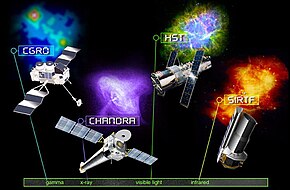
NASA's series of Great Observatories satellites are four large, powerful space-based astronomical telescopes launched between 1990 and 2003. They were built with different technology to examine specific wavelength/energy regions of the electromagnetic spectrum: gamma rays, X-rays, visible and ultraviolet light, and infrared light.
The Hubble Space Telescope (HST) primarily observes visible light and near-ultraviolet. It was launched in 1990 aboard the Space Shuttle Discovery during STS-31, but its main mirror had been ground incorrectly, resulting in spherical aberration that compromised the telescope's capabilities. The optics were corrected to their intended quality by the STS-61 servicing mission in 1993. In 1997, the STS-82 servicing mission added capability in the near-infrared range, and in 2009 the STS-125 servicing mission refurbished the telescope and extended its projected service life. It remains in active operation as of October 2024[update].
The Compton Gamma Ray Observatory (CGRO) primarily observed gamma rays, though it extended into hard x-rays as well. It was launched in 1991 aboard Atlantis during STS-37. It was de-orbited in 2000 after a gyroscope failed.
The Chandra X-ray Observatory (CXO) primarily observes soft X-rays. It was launched in 1999 aboard Columbia during STS-93 into an elliptical high-Earth orbit, and was initially named the Advanced X-ray Astronomical Facility (AXAF). It remains in active operation as of October 2024[update].
The Spitzer Space Telescope (SST) observed the infrared spectrum. It was launched in 2003 aboard a Delta II rocket into an Earth-trailing solar orbit. Depletion of its liquid helium coolant in 2009 reduced its functionality, leaving it with only two short-wavelength imaging modules. It was removed from service and placed into safe-mode on January 30, 2020.